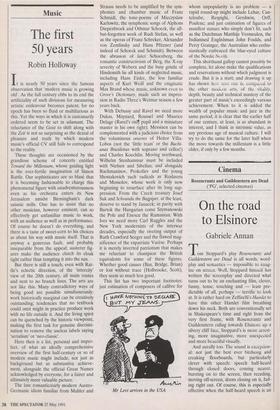Music
The first 50 years
Robin Holloway
It is nearly 50 years since the famous observation that 'modern music is growing old'. As the full century ebbs to its end the artificiality of such divisions for measuring artistic endeavour becomes patent, for no epoch has been so fluid or multifarious as this. Yet the ways in which it is customarily ordered seem to be set in adamant. The reluctance of the Geist to shift along with the Zeit is not so surprising as the denial of pleasure and truth by which modern music's official CV still fails to correspond to the reality.
These thoughts are occasioned by the grandiose scheme of concerts entitled Toward the Millenium, whose guiding light is the ever-fertile imagination of Simon Rattle. Our sophisticates are so blasé that it is becoming fashionable to charge this phenomenal figure with unadventurousness even as his orchestra enters its New Jerusalem amidst Birmingham's dark satanic mills. One has to insist that no other musician, however eminent, can so effectively get unfamiliar music to work, with an audience as well as in performance. Of course he doesn't do everything, and there is a taste of sweet-corn to his choices as about his way with music itself. That is anyway a generous fault, and probably inseparable from the appeal; austerer fig- ures make the audience clutch its cloak tight rather than tempting it into the sun.
But there is still a touch, even with Rat- tle's eclectic direction, of the 'intercity' view of the 20th century, all main routes and next to no branch lines. The arts are not like this. Many contradictory ways of being good are possible simultaneously: work historically marginal can be creatively outstanding; tendencies that no textbook could omit might in practice produce work with no life outside it. And the living spirit can be quenched by the historic viewpoint, making the first task for genuine discrimi- nation to remove the useless labels saying `serialism' or 'neo-classic'.
Here then is a list, personal and imper- fect, of what an ideally comprehensive overview of the first half-century or so of modern music might include, not just as background but as substantive achieve- ment, alongside the official Great Names acknowledged by everyone, for a fairer and ultimately more valuable picture.
The late romantic/early modern Austro- Germanic idiom familiar from Mahler and
Strauss needs to be amplified by the sym- phonies and chamber music of Franz Schmidt, the tone-poems of Mieczyslaw Karlowitz, the symphonic songs of Alphons Diepenbrock and Othmar Schoeck, the all- but-forgotten work of Rudi Stefan, as well as the operas of Franz Schreker, Alexander von Zemlinsky and Hans Pfitzner (and indeed of Schoeck and Schmidt). Between the abrasion of later Schoenberg, the romantic constructivism of Berg, the X-ray severity of Webern and the busy gristle of Hindemith lie all kinds of neglected music, including Hans Eisler, the less familiar aspects of Kurt Weill and the enigmatic Max Brand whose music, unknown even to Grove's Dictionary, made such an impres- sion in Radio Three's Weimar season a few years back.
With Debussy and Ravel we need more Dukas, Maynard, Roussel and Maurice Delage (Ravel's only pupil and a miniature master in his own right). Messiaen can be complemented with a judicious choice from the voluminous oeuvres of Heitor Villa- Lobos (not the 'little train' or the Bachi- anas Brasileiras with soprano and cellos!) and Charles Koechlin. Moving northward, Wilhelm Stenhammar must be included with Nielsen and Sibelius; and alongside Rachmaninov, Prokofiev and the young Shostakovich such radicals as Roslavets and Mossolov, whose work is only now beginning to resurface after its long sup- pression. From the Czech treasury Josef Suk and Schvanda the Bagpiper, at the least, deserve to stand by Janacek; in parity with Bartok the Hungarian come Szymanowski the Pole and Enescu the Rumanian. With Ives we need more Carl Ruggles and the New York modernists of the interwar decades, especially the riveting output of Ruth Crawford Seeger and the flawed mag- nificence of the expatriate Varese. Perhaps it is merely inverted patriotism that makes me reluctant to champion the British equivalents for some of these figures. Whether good causes (Bax, Bridge, Brian) or lost without trace (Holbrooke, Scott), they seem so much less good.
This list has two important footnotes: just estimation of composers of calibre for Mr Levi arrives in the USA whom unpopularity is no problem — a rapid round-up might include Lehar, Can- teloube, Respighi, Gershwin, Orff, Poulenc; and just estimation of figures of manifest stature who simply don't fit, such as the Dutchman Matthijs Vermeulen, the Indianised Englishman John Foulds, and Percy Grainger, the Australian who enthu- siastically embraced the blue-eyed culture of the Nordic Nui th.
This shorthand gallop cannot possibly be complete, let alone make the qualifications and reservations without which judgment is crude. But it is a start; and drawing it up has shown how sure one is, compared to the other mode-rn arts, of the vitality, depth, beauty and technical mastery of the greater part of music's exceedingly various achievement. When to it is added the wealth of popular music and jazz in the same period, it is clear that the earlier half of our century, at least, is as abundant in interest, and I think in intrinisic value, as any previous age of musical culture. I will try to do the same for the later half when the move towards the millenium is a little older, if only by a few months.


















































 Previous page
Previous page